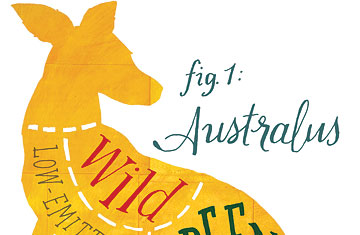
It's no small thing to rebrand a national icon — particularly if you're rebranding it as a meat product. A few years ago, Australia's food industry was trying to figure out how to get more people to think of the kangaroo, which is part of the country's official coat of arms, as something that is edible rather than adorable. In 2005, the trade magazine Food Companion International ran a global competition for suggestions on what to call kangaroo meat. The magazine received 2,700 entries from more than 40 nations. Proposed names included rooviande, kangasaurus, jumpmeat and MOM (meat of marsupials). The winner was something more taxonomic: kangaroo for consumption would be known as australus.
The name hasn't really caught on, but the meat certainly has. In the past three years, Australian sales of kangaroo have increased 30% as it has gained more cred as a healthy and free-range alternative to lamb and beef. Now, with a recession in full swing, the relatively inexpensive, lean red meat is moving even faster. "Sales are going through the roof," says Ray Borda, owner of Adelaide-based Macro Meats, a meat-processing company that sells about 200 tons of kangaroo meat per week. "One, it's cheaper. Two, it's better for you. Three, it's better for the environment. It ticks all the boxes. People can't ignore it anymore."
Roo has been eaten for millennia, but it fell deeply out of fashion shortly after Captain Arthur Phillip sailed ashore in 1788 with six cows, 29 sheep and 717 English convicts to form the first British colony in New South Wales. Non-native herd animals replaced the nomadic Skippy as the continent's meat source of choice. Australia began exporting kangaroo in 1959, and many an Aussie dog has feasted on it for decades. But it wasn't until the 1990s that most Australian states legalized the domestic sale of kangaroo as people food. John Kelly, executive director of the Kangaroo Industry Association of Australia (KIAA), blames the British palate. "If the French had gotten here first, the kangaroo would have been our national dish," he says. "Instead, we got meat and three veg."
Today, roo meat is sold as everything from sausage filling in Russia to a high-end game meat served in Australia's best restaurants. "It's a sweeter meat that has no visible fat marbling. It's very lean," says Ray Mauger, executive chef at Adelaide's Red Ochre Grill, which has been serving it since the 1980s. Kangaroos are mostly harvested in the wild for population control, hunted at night by licensed shooters who sell to processing plants. Only four out of 55 kangaroo species can be culled for commercial use. In 2002, the national quota was at a high of nearly 7 million, but as kangaroo populations declined with dry weather, that number has been reduced by half.
The fact that kangaroos run free helps keep their meat cheap. Because there's no need for complex infrastructure, feed or veterinary care, it costs 20-30% less than beef. Kangaroos also do less damage to Australian soil than millions of hard-hoofed cows and sheep. And unlike ruminants, which produce gases that contribute 11% of Australia's greenhouse-gas emissions, kangaroos are naturally low greenhouse-gas emitters. The industry got a boost last fall when Ross Garnaut, Prime Minister Kevin Rudd's top climate-change adviser, issued a global-warming report urging Australians to chuck their beef and lamb and throw more roo on the barbie.
Not everyone is following that advice. Despite recent gains, the average Aussie today eats less than a quarter of a kilo of kangaroo a year, compared with more than 37 kg of beef and veal. In 2007, the entire kangaroo industry, which includes pet-food and hide sales, was valued at about $30 million, compared to over $1.4 billion for Australia's sheep business. "I'm sure those producing kangaroo got a bounce out of [Garnaut's report], if you'll pardon the pun," says Brett Heffernan, a spokesman for the National Farmers' Federation. "But it's not likely to take over traditional cattle and lamb and everything else. There's still a long way to go for the industry to solidify itself." Animal-rights groups oppose kangaroo culling; the famously vegetarian Paul McCartney even jumped into the fray last year, speaking out against a controversial cull in Canberra. "Our organization does not encourage the eating of our national icon," says Karen Scott, vice-president of Wildcare Australia, a conservation group that rescues native animals.
Still, a recent study found that 76% of Australians living in Canberra, where kangaroos are common, supported culling to control population, and more than half supported culling for commercial purposes. With a little help from global warming and the recession, the industry's biggest p.r. challenges may be behind it. "People are smart; they will Google anything and make up their own mind," says Borda of Macro Meats. "It just needs to do its time." Australus may not be the new beef yet, but Borda and others in the business hope demand will keep growing by leaps and bounds.
